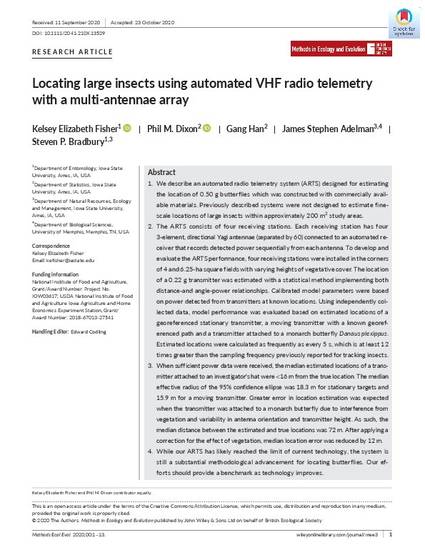
Article
Locating large insects using automated VHF radio telemetry with a multi‐antennae array
Methods in Ecology and Evolution
Document Type
Article
Disciplines
Publication Version
Published Version
Publication Date
1-1-2020
DOI
10.1111/2041-210X.13529
Abstract
- We describe an automated radio telemetry system (ARTS) designed for estimating the location of 0.50 g butterflies which was constructed with commercially available materials. Previously described systems were not designed to estimate fine‐scale locations of large insects within approximately 200 m2 study areas.
- The ARTS consists of four receiving stations. Each receiving station has four 3‐element, directional Yagi antennae (separated by 60) connected to an automated receiver that records detected power sequentially from each antenna. To develop and evaluate the ARTS performance, four receiving stations were installed in the corners of 4 and 6.25‐ha square fields with varying heights of vegetative cover. The location of a 0.22 g transmitter was estimated with a statistical method implementing both distance‐and angle‐power relationships. Calibrated model parameters were based on power detected from transmitters at known locations. Using independently collected data, model performance was evaluated based on estimated locations of a georeferenced stationary transmitter, a moving transmitter with a known georeferenced path and a transmitter attached to a monarch butterfly Danaus plexippus. Estimated locations were calculated as frequently as every 5 s, which is at least 12 times greater than the sampling frequency previously reported for tracking insects.
- When sufficient power data were received, the median estimated locations of a transmitter attached to an investigator's hat were95% confidence ellipse was 18.3 m for stationary targets and 15.9 m for a moving transmitter. Greater error in location estimation was expected when the transmitter was attached to a monarch butterfly due to interference from vegetation and variability in antenna orientation and transmitter height. As such, the median distance between the estimated and true locations was 72 m. After applying a correction for the effect of vegetation, median location error was reduced by 12 m.
- While our ARTS has likely reached the limit of current technology, the system is still a substantial methodological advancement for locating butterflies. Our efforts should provide a benchmark as technology improves.
Creative Commons License
Creative Commons Attribution 4.0 International
Copyright Owner
The Authors
Copyright Date
2020
Language
en
File Format
application/pdf
Citation Information
Kelsey Elizabeth Fisher, Phil M. Dixon, Gang Han, James Stephen Adelman, et al.. "Locating large insects using automated VHF radio telemetry with a multi‐antennae array" Methods in Ecology and Evolution (2020) Available at: http://works.bepress.com/philip-dixon/76/

This article is published as Fisher, K. E., P. M. Dixon, G. Han, J. S. Adelman, and S. P. Bradbury. "Locating large insects using automated VHF radio telemetry with a multi‐antennae array." Methods in Ecology and Evolution (2020). doi: 10.1111/2041-210X.13529.